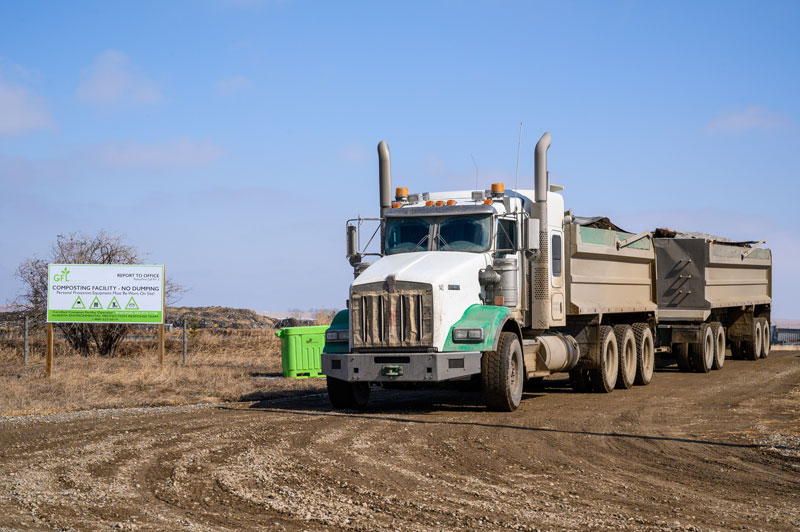GFL “legacy pile” being hauled away; concerns remain
By Sean Feagan, Local Journalism Initiative Reporter


Sean Feagan Photo
The Green for Life (GFL) Strathmore Compost Facility garnered an outcry from residents who report the site generates unbearable smells and contains potentially harmful compounds, including asbestos and hydrogen sulphide (H2S).
“It’s been a nightmare,” said local resident Joe Vergouwen.
The smells allegedly originate from a deposit on the site of decaying organic materials, referred to as the “legacy pile,” a term that some residents find offensive, just like the odours it emits.
“I don’t know why they call it a legacy pile – it’s rotten garbage,” said Colin Huxted, a local resident and member of Neighbours Against Pollution (NAP), a group of residents who have fought against the conditions and practices at the site.
Some of the material at the site is drywall, rather than compost material, originating from a landfill in Kelowna, B.C., said Huxted. Previously, when this material was pulverized on site, it spread via the wind to adjacent properties.
“The soil was white out there on the neighbouring land,” said Huxted.
When residents tested the contents of the dust arriving on their properties, they found some samples contained asbestos, a mineral that can cause respiratory illnesses and cancer, at concentration levels exceeding provincial guidelines, he added.
While Huxted is encouraged that “at least something is being done,” getting GFL to address the problem has been a long and difficult road.
“It’s been a court battle all the way through; they’ve done everything they could to delay and stall,” said Huxted. “These guys promised way back in 2017 that in three months they would have it all gone. We finally had to threaten to sue the county for $20 million to make them make a move on GFL to make them clean it up.”
The site’s odour problem might get worse before it gets better, said Huxted.
“I’m hoping this is going to help the problem, but because this stuff has been piled up for so long, any time they open it up, that’s when we get all the odours,” he noted. “We want to see everyone get their lives back out here so they can actually enjoy things like barbecues on the weekend and weddings.”
The site was prepared for the legacy pile removal on April 1. Material removal started on April 2 and is ongoing. The company must complete removal activity by June 30, 2020 – meaning the material will be hauled out throughout the spring, contrary to previous assurances by GFL, said Huxted.
“They said they were going to haul it through the winter months so that we weren’t affected during the summer. Are we happy? Now we have a bunch of trucks coming through, but at least this stuff is going out,” said Huxted. “As long as new stuff is not coming in until they get everything cleaned up and done right.”
Throughout the pile removal, GFL will provide updates on removal activities, H2S levels, the number of truckloads removed and the amount of hauled material, according to an update on Wheatland County’s website.
GFL may have to do more than remove the pile to get the approval of some residents.
“Moving the piles is the first step in a long road to get that area back to a functional compost facility in my opinion, without prejudice,” said resident Colin McGovern, who wrote an open letter expressing concern about the site and the associated hauling operation. “It’s a garbage dump; it’s not a compost facility.”
“I would like to see it cleaned up, do some actual testing there of the ground water, get rid of that leachate pond, do some soil samples, and actually test that material that they have hauled out of there because it has been proven to have asbestos in it,” he said.
“I’m not very trustful of GFL – they have been a poor neighbour and a poor corporate citizen.
